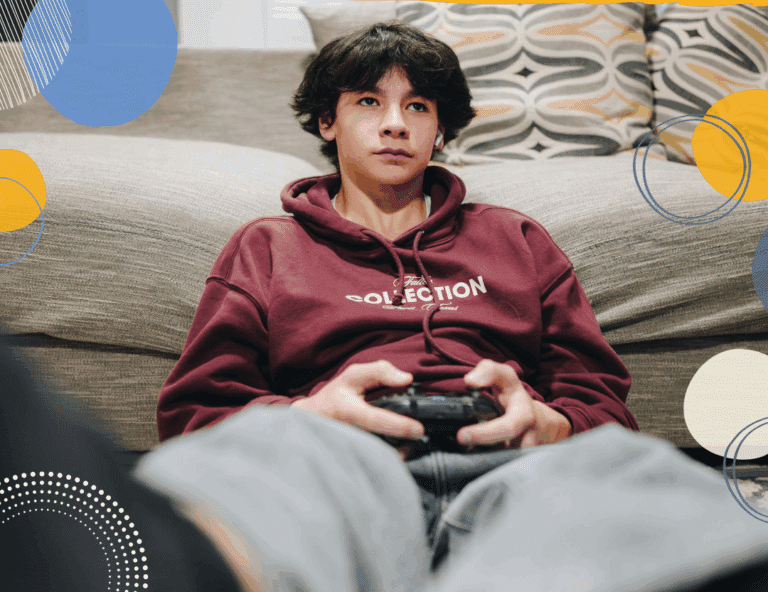Setting screentime limits for teens in the school holidays
Battling with teens over screentime is exhausting. Lack of structure and routine during long school holidays only makes this worse – especially when parents are working and can’t supervise (because working parents don’t get six weeks off!).
So, how can we encourage teens to balance online and offline time in the school holidays without causing conflict?
Digital devices hold a magnetic pull for teenagers. Their developing brains find it hard to regulate their own screen use, and many of their natural preoccupations (such as friendships and identity exploration) can be found online. It’s easy for them to get sucked in to screens and hard for them to pull away.
Parents need to counterbalance this magnetic pull of tech by:
- encouraging a wide range of real-world activities
- designating tech-free spaces in family life
- consistent rules and screentime limits
Encourage real world activities
Aim for balance rather than perfection. A little bit of recreational screentime over the holidays is fine but daily 12-hour gaming binges are not healthy. Work with your teen to organise a structure of activities that will get them moving and connecting with people (see How to tempt your teen off tech for ideas).
You are much more likely to persuade a reluctant teen to agree to this if you approach them in a spirit of collaboration and compromise. Give them lots of control and choices whilst also making your non-negotiables clear:
- “The school holidays are coming up and we need to think about how you are going to spend your time. I know you’ll want some downtime, that’s fine. But it’s not good for you to spend the entire time on screens. Will you have a think and see if you can come up with ideas for some things you’d like to do and we’ll work out how to make those happen?”
Try to co-design a schedule around their needs and interests. And don’t be put off if they keep knocking back your ideas.
- “My idea is you could just back off, leave me alone and let me get on with my life!”
- “Yes, I can see how you might prefer that. But fortunately you have a parent who cares about your wellbeing. So, we’d better look for some compromises.”
Don’t give up. Timing is everything with teens. Just because your teenager knocks you back doesn’t mean it wasn’t a good idea or that it isn’t worth trying again (and again and again…). Some days a banal idea will get a teenager off their phone and happily engaging while on other days, the best idea on earth won’t work.
Tech-free spaces in family life
A whole family approach is essential here. Teens are the first ones to call us hypocrites if we ban them from their phones while still scrolling our own. Find opportunities to side line technology within your family culture (for everyone) and create lots of tech-free buffers in your family life.
Family habits and rituals can be really helpful here, so make sure you keep these going during the school holidays. The best family rituals naturally push tech aside with having to fight about it every time. These could include eating meals together (phone-free), playing board games, weekend walks, or sports (watching or playing). You might need to adapt these to summer schedules (e.g. having Sunday brunch together rather than an evening meal) but keep eating together and playing together as much as possible.
Setting screentime limits
With younger teens (and those who are not good at regulating their own screentime), you will also need to set some screentime limits. This can be trickier in the school holidays if you are not at home to supervise.
The key is to put in place a system in which their choices have consequences. Of course, you don’t want them on their console all day and night, so you’ll have to structure the choices available.
This isn’t about using threats (Turn it off or I will do something you don’t like!). This is about acknowledging that teens have the power to choose but weighting the consequences in order to lead our teen in a positive direction.
If your teen loves gaming, for example, you could position gaming as conditional on certain other choices being made first. You might structure their choices by making gaming time contingent on participating in some non-tech activities first. They can have an afternoon/day for gaming as long as they have participated in a positive healthy activity first. if they choose not to, their device will not be available for that afternoon/day.
You can make this system even more adult by formalising it into a written contract (signed by you both), stipulating how much gaming time is acceptable and the conditions under which gaming is allowed.
If it helps to gain some co-operation from your teen, start off by agreeing an allowance of how much time they can have playing games each day (on a console or computer) with no strings attached. Be sure to make this time allocation smaller than your teen will want but also smaller than the maximum gaming time you are prepared to allow. If your teen wants additional gaming time on top of their allowance, that will be dependent on other conditions being met first.
The first time you attempt a gaming contract, lots of things will go wrong. You’ll discover an unforeseen loophole or perverse incentive that you hadn’t anticipated. The gaming time they end up with will either be too high or too low. You’ll realise that you have no way of checking whether certain conditions have been fulfilled. Your teen will shout at you for the choices they have made. But persist. Review the contract after a week to tweak it.
Ultimately, our aim is for teens to learn to self-regulate their own screentime in a way that is healthy and good for them.
Good luck – and let me know how you get on!
Found this helpful? There are loads more ideas in my new book How to Get Your Teenager Out of Their Bedroom.









Leave a Reply